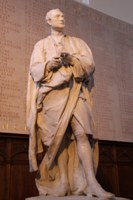Statues in the Ante-Chapel
In the Ante-Chapel are statues of six great Trinity men: 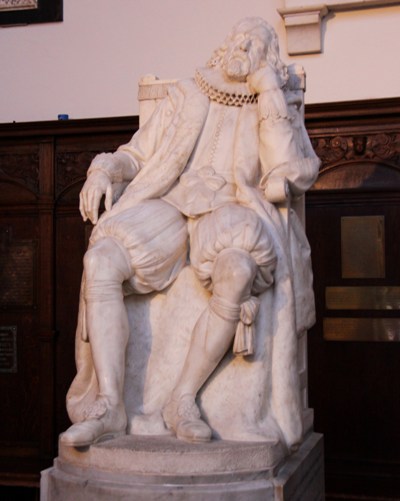
Francis Bacon (1561-1626) was the 1st Viscount St Alban, known as the father of empiricism and first modern philosopher and theorist. Admitted to Trinity at just thirteen years old, while an undergraduate he first met Queen Elizabeth, who was impressed by his precocious intellect, and was accustomed to calling him “the young Lord Keeper”. Thomas Jefferson wrote: “Bacon, Locke and Newton; I consider them as the three greatest men that have ever lived, without any exception, and as having laid the foundation of those superstructures which have been raised in the Physical and Moral sciences”. (John Locke studied at Trinity’s sister college, Christ Church, Oxford.) Bacon was Lord Chancellor 1618-21.
Bacon's death from pneumonia was described in John Aubrey's "Brief Lives" as the result of his idea of using snow to preserve meat. This statue, a copy of one at Gorhambury in Hertfordshire, claims to depict the way Bacon sat. The sculpture is very fine, realistically depicting the fur and lace of his clothes; in places the marble is thin enough to be translucent. Sculptor: Henry Weekes, 1845
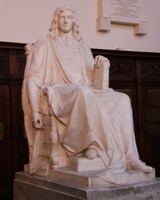 Isaac Barrow (1630-77) distinguished himself in Classics, Mathematics and Divinity. He was appointed Regius Professor of Greek three years before becoming the first Lucasian professor of Mathematics – an illustration of the way the elements of the quadrivium were closely connected in the seventeenth century. Best known for his discovery of the fundamental theorem of calculus, Barrow resigned the Lucasian chair in favour of his pupil Isaac Newton, and devoted the rest of his life to theology – writing and preaching – and to being the Master of Trinity (1672-77) who commissioned the Wren Library.
Isaac Barrow (1630-77) distinguished himself in Classics, Mathematics and Divinity. He was appointed Regius Professor of Greek three years before becoming the first Lucasian professor of Mathematics – an illustration of the way the elements of the quadrivium were closely connected in the seventeenth century. Best known for his discovery of the fundamental theorem of calculus, Barrow resigned the Lucasian chair in favour of his pupil Isaac Newton, and devoted the rest of his life to theology – writing and preaching – and to being the Master of Trinity (1672-77) who commissioned the Wren Library.
The statue of Barrow was commissioned in preference to one of Richard Bentley, who was a more influential but also highly controversial Master. “The foremost scholar and textual critic of his day”, Bentley was regarded, together with Newton, as one of the ‘intellectual founders’ of Trinity, but as Master he “ruled like an irresponsible despot”. The statues of Bacon and Barrow were given by William Whewell. Sculptor: Matthew Noble, 1858
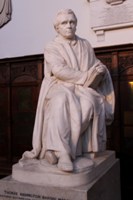 The inscription under Lord Macaulay’s statue, by Thomas Woolner (1868), one of the best of the many specimens of elegant Latinity on the memorials, contains the appropriate words “Qui primus annales ita scripsit ut vera fictis libentius legerentur” (He was the first to write history in such a way that the true facts might be read with more pleasure than fiction). He was the author of the Lays of Ancient Rome, which contains the lines, memorised by many schoolchildren: Then out spake brave Horatius, / The Captain of the Gate: / 'To every man upon this earth / Death cometh soon or late. / And how can man die better / Than facing fearful odds, / For the ashes of his fathers, / And the temples of his Gods'.
The inscription under Lord Macaulay’s statue, by Thomas Woolner (1868), one of the best of the many specimens of elegant Latinity on the memorials, contains the appropriate words “Qui primus annales ita scripsit ut vera fictis libentius legerentur” (He was the first to write history in such a way that the true facts might be read with more pleasure than fiction). He was the author of the Lays of Ancient Rome, which contains the lines, memorised by many schoolchildren: Then out spake brave Horatius, / The Captain of the Gate: / 'To every man upon this earth / Death cometh soon or late. / And how can man die better / Than facing fearful odds, / For the ashes of his fathers, / And the temples of his Gods'.
Thomas Babington Macaulay (1800-59) was a great historian, but some of his views would today be regarded as suspect: he was convinced that “universal suffrage [the right to vote] is incompatible… with all forms of government, and … that it is consequently incompatible with civilisation.”
William Whewell (1794-1866) spent his whole adult life at Trinity, 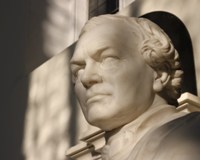 coming up as an Exhibitioner in 1812, and dying as Master in 1866, after falling from a horse. He was Professor of Mineralogy, and subsequently of Philosophy (then called “moral theology and casuistical divinity”), and endowed a chair of international law; he was also interested in architecture and, having presciently bought the land, he signed the contract for, and contributed financially to, the Gothic courts east of Trinity Street named in his honour but built in “the worst period of Victorian architecture”.
coming up as an Exhibitioner in 1812, and dying as Master in 1866, after falling from a horse. He was Professor of Mineralogy, and subsequently of Philosophy (then called “moral theology and casuistical divinity”), and endowed a chair of international law; he was also interested in architecture and, having presciently bought the land, he signed the contract for, and contributed financially to, the Gothic courts east of Trinity Street named in his honour but built in “the worst period of Victorian architecture”.
He is chiefly remembered for his encouragement of the study of the moral and natural sciences; he also coined many scientific terms, including the word scientist. As well as being a polymath with a prodigious memory, Whewell was as powerful physically as his statue suggests. “It is a well-authenticated Trinity tradition that Whewell, when Master, jumped up the Hall steps at one leap, a feat that is very seldom accomplished even by youthful athletes.” Sculptor: Thomas Woolner, 1872
In the bas-relief of the statue of the poet Alfred, Lord Tennyson (1809-92) a pipe bowl lies 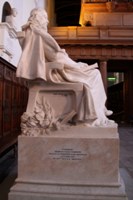 half-hidden among the laurel wreaths; children always delight in its discovery. It was put there by a secret conspiracy between the sculptor Thornycroft and the donor Harry Yates Thompson, a life-long friend of the then Master Montagu Butler, who was well aware of the Master’s dislike of the nasty habit of smoking. Tennyson won the Chancellor's Medal for poetry, but left Trinity without a degree, owing to his father's illness.
half-hidden among the laurel wreaths; children always delight in its discovery. It was put there by a secret conspiracy between the sculptor Thornycroft and the donor Harry Yates Thompson, a life-long friend of the then Master Montagu Butler, who was well aware of the Master’s dislike of the nasty habit of smoking. Tennyson won the Chancellor's Medal for poetry, but left Trinity without a degree, owing to his father's illness.
The much-quoted Tennyson was the author of The Charge of the Light Brigade, Crossing the Bar, and In Memoriam, which he wrote to commemorate his friend Arthur Hallam, another Trinity poet, and which contains the immortal lines ’Tis better to have loved and lost / Than never to have loved at all. Verse 87 is a nostalgic sketch of life at Trinity. Sculptor: Sir Hamo Thornycroft, 1909
Louis-François Roubiliac’s 1755 statue of Isaac Newton, presented to the Ante-Chapel by the Master Robert Smith, “is the finest work of art in the College, as well as the most moving and significant. The lips parted and the eyes turned up in thought give life to marble. The inscription, Qui genus humanum ingenio superavit, is a pun ennobled by its truth”. This inscription is a quotation from the third book of Lucretius’s De rerum natura, meaning ‘in intellect he surpassed / survived the human race’.
Newton (1642-1727) was the greatest English mathematician of his generation. Developing his teacher Isaac Barrow’s work he laid the foundation for differential and integral calculus. His work on optics and gravitation make him one of the greatest scientists the world has known. His 1687 book Philosophiæ Naturalis Principia Mathematica lays the foundations for most of classical mechanics. He also excelled in the realms of astronomy, natural philosophy, alchemy, and somewhat unorthodox theology. Newton is buried in Westminster Abbey.
Click on the link or image below to see a gallery of the statues. The gallery pictures lead to further information about the persons commemorated.
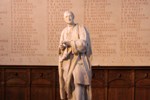 |
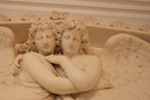 |
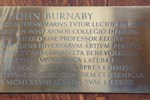 |
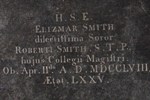 |
| Gallery of statues | Sculptures | Brasses | Interments |

